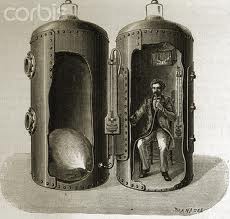About Hypoxia and Hyperoxia. The Differences and causes.
These word might be new to the recreational diver that softly ventures into the magic of using nitrox, familiar to the seasoned technical diver, but as a matter of fact, these words are centuries old.
The words Hyp- and Hyper- are from the latin ‘too little’ and ‘more than’
It reflects the comparison with a 3rd word you will come accros; Normoxia. Normoxia describes oxygen levels similar to those at sea level and is commonly known as 21% of oxygen (normal breathing air)
Hypoxia describes levels lower than Normoxia, or percentages lower than 21%.
In Diving, we usually describe a mixture with less than 16% of oxygen as a ‘hypoxic breathing gas’, which typically contains an amount of helium to diffuse the toxic effects of oxygen and nitrogen, which make up 99% of normal breathing air. These mixes are commonly referred to as ‘Trimix’ (oxygen, helium and nitrogen) or ‘Heliox’ (helium and oxygen)

We talk about a hyperoxic breathing gas when levels rise above 22% of oxygen. These gasses are especially beneficial when doing longer dives and divers don’t want too much nitrogen in their breathing mixture, as this would impose decompression stops. Mixtures with 30% of oxygen or more are very popular in the modern diving industry and referred to as ‘Nitrox’. Nitrox mixtures can also be used by deep divers as means to make their decompression go faster during long decompression stops.
Tolerable levels of hyperoxia and hypoxia have been described some 200 years ago by Priestley and Bert and set to minimum 16% and maximum 50% of oxygen for an individual to breathe indefinitely. These levels are still a parameter for commercial divers, spending weeks at a time in decompression chambers, breathing hyperoxic helium mixtures.
What happens if you cross the boundaries? Hypoxia will first cause confusion and slow response of the diver. Once levels fall below 10%, unconsciousness sets in and in lower levels, the brain finally shuts down.
In hyperoxic conditions, it depends how high the dosis is. If the percentage ranges from 50%-100% of oxygen, for periods in excess of 12 hours, the individual may suffer so-called pulmonary oxygen toxicity. A form of pneumonia, where the lungs are damaged and inflamed from prolonged exposure to the dry and aggressive effects of oxygen.
In hyperbaric conditions , where the pressure is above sealevel (whilst diving or in hyperbaric chambers) the pressure of oxygen can rise even higher. Since it is theoretically impossible to breathe more than 100% oxygen, divers and scientists rather express the amount of oxygen received in
Oxygen Partial Pressure, more precisely PpO2, which is set in Atmospheres Absolute (ATA).
A 21% air mix gives a partial pressure of 0,21 ATA at sealevel. 100% will give 1ATA, 50% will give 0.5ATA.

Once the surrounding pressure is increased, so will the oxygen partial pressure .(Daltons’ Law) this way, the oxygen pressure can go well above the 1ATA.
Once the pressure goes over 1,6 ATA, another dangerous phenomenon comes into play; Central Nervous System Oxygen Toxicity. This is a problem with divers breathing high oxygen containing mixtures at depth. They should plan their ‘oxygen exposures’ carefully. A diver suffering central nervous system oxygen toxicity (CNS OxTox) will experience a variety of symptoms with the worst being a full blown epileptic seizure, in old books reffered to as the Paul Bert Effect ‘grand Mal’ type seizure, after the scientists who first documented this.
Lately, scientists seem to relate both pulmonary and CNS oxygen toxicity as originating from the lungs and the involvement of Nitrous Oxide and the depletion thereof in the body.
The last gasses that require attention for the diver are Carbon Dioxide and Carbon monoxide.
Carbon dioxide is a waste product from the consumption of oxygen in our body. For every liter of oxygen metabolized , we exhale about 0,8L of carbon dioxide. Carbon dioxide triggers our respiration; the more carbon dioxide present in our lungs, the faster we are urged to breathe. Doing hard work under water, or fighting a current will increase the demand for respiration. If that demand is not met, a build-up for carbon dioxide in the body is imminent. Too much in the blood will make the blood go slightly acidic (acidosis), usually resulting in headache, nausea after diving. Extreme cases can end in unconsciousness of the diver, usually when taking air to great depths. This is the main reason why training agencies advocate well maintained breathing apparatus and a good physical condition before partaking diving, deep diving in general.

Carbon monoxide is one of the most dangerous gasses in diving. It is produces when an ‘incomplete bruning process takes place(no flame seen), like the exhasuts of a car orboat, cigarette smoke, or an overheated air compressor. If any carbon monoxide ends up in the scuba tank of the diver, the gas will end up in the divers’ blood stream, occupying all the hemoglobin found in the divers red blood cells. Hemoglobin is use to transport oxygen to the divers’ tissues. With this being paralyzed , the diver slowly suffocates if no immediate oxygen and medical help is presented. The cherry red lips and nails are a common sign.
By Ben Reymenants
